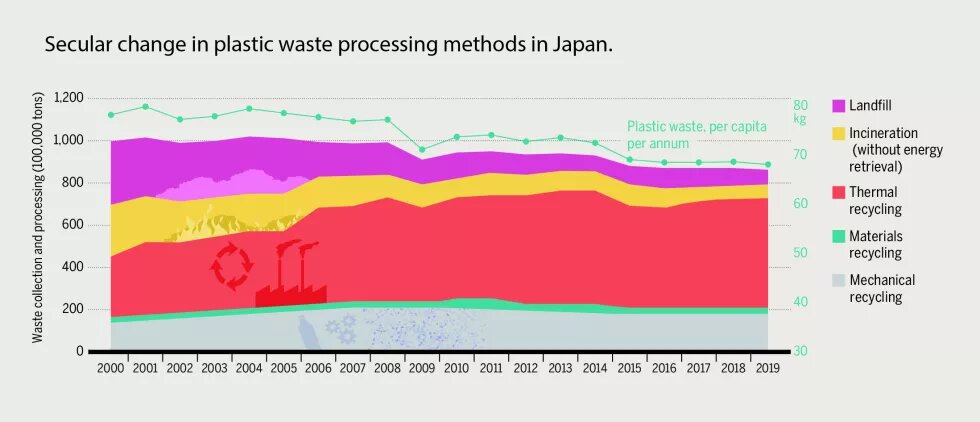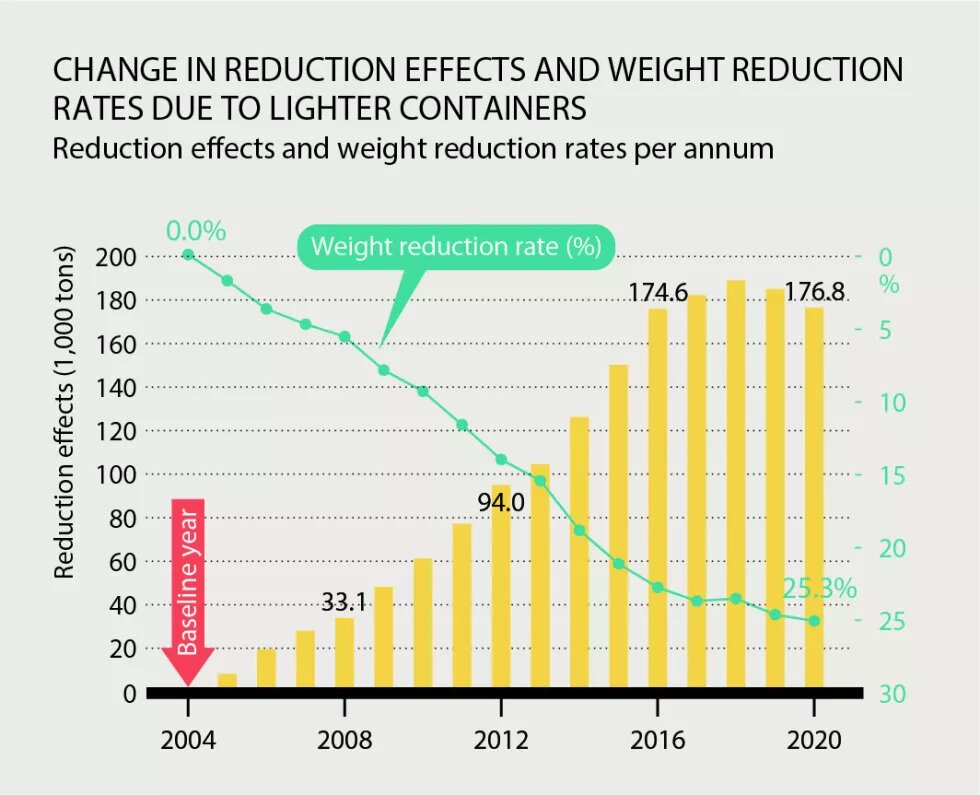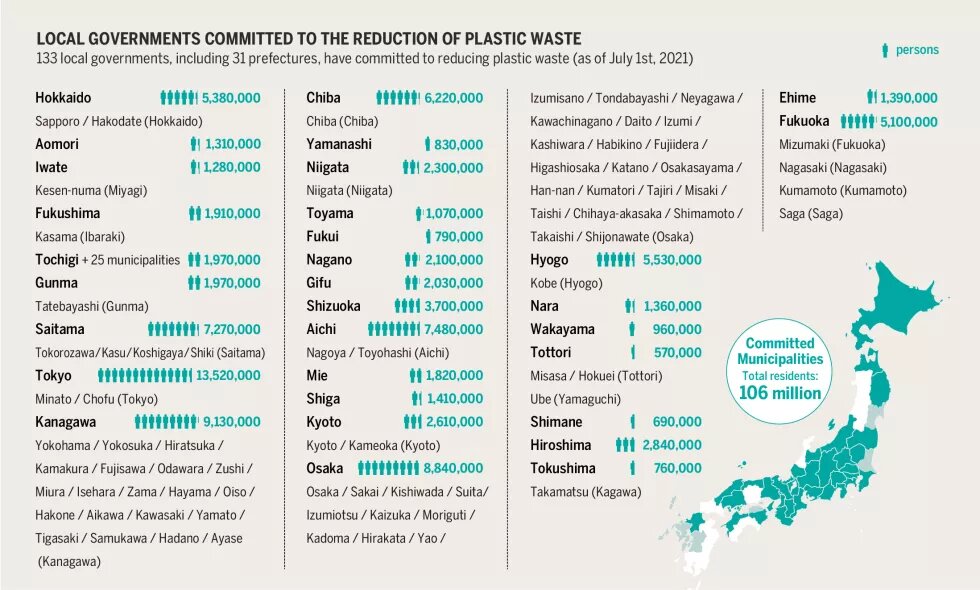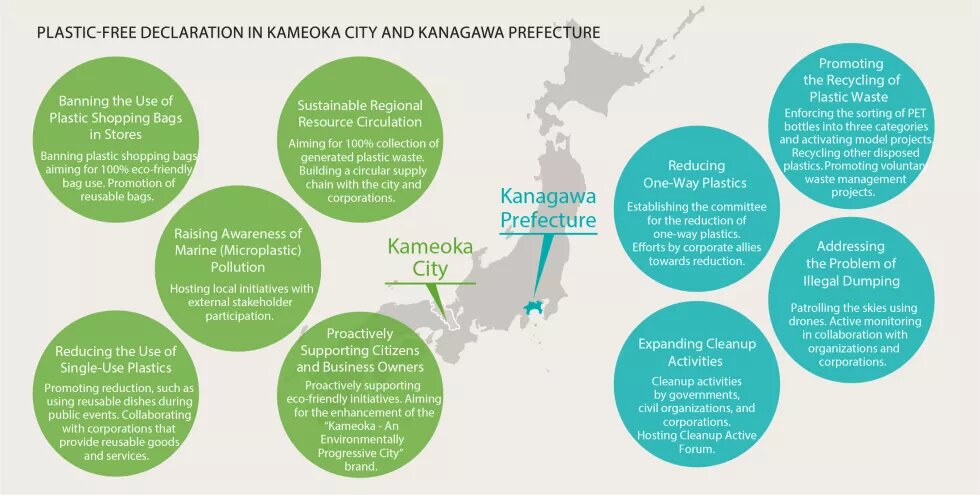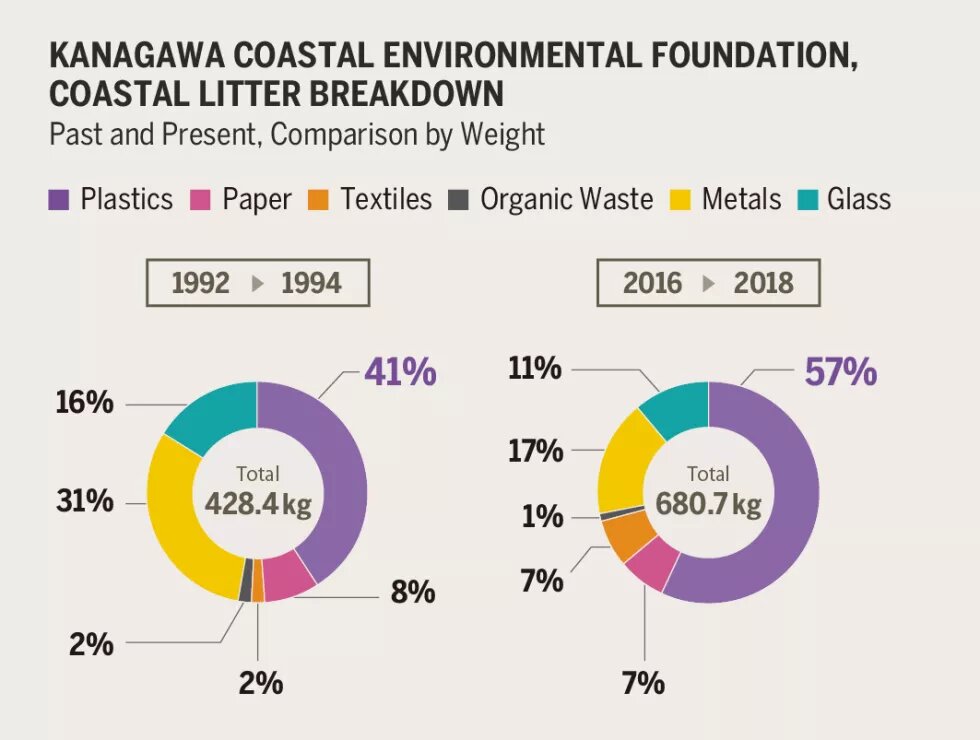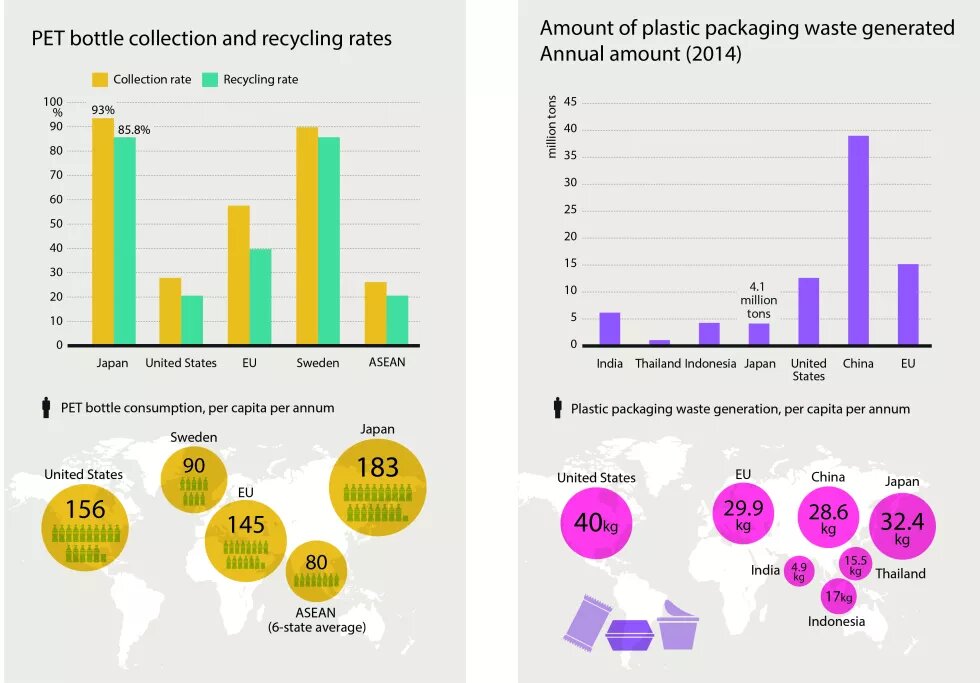
Plastic Atlas Japan Special Edition (6 pages in English)
Japan’s Plastic Waste Management – Challenges and Potential Solutions
Japan has the second highest plastic management index (PMI) in the world, thanks to its advanced waste management system and high levels of local cooperation. On the other hand, Japan’s per capita plastic consumption is also quite high. Innovative policies, strategies, and action plans are required for Japan to promote the circulation of resources and build a sustainable lifestyle and society.
Japan has a cutting-edge plastic waste management system, advanced infrastructure, and various other technologies and policies for recycling and waste processing, not to mention a proactive system of cooperation with citizens and companies. According to the plastic management index (PMI), a metric for comparing countries’ performances on plastic waste management from various angles, Japan is ranked second after Germany out of 25 countries. Moreover, Japan is among the top countries in the world when it comes to managing PET bottles, with a collection rate of 93% and a recycling rate of 85.8% (as of 2019). As for collection channels, 46% rely on local governments and organizations, while 54% rely on businesses, including PET bottle-specific trash cans installed beside vending machines and other collection boxes.
However, waste management policies and their implementation are not sufficient for addressing the global marine plastic pollution crisis. Over the past few years, the amount of plastic waste among general waste has been rising in Japan, reaching 4.1 million tons in 2019. More than three-quarters (77.2%) of this figure consist of single-use containers and packaging. Indeed, in terms of per capita plastic packaging waste emissions, Japan ranks second in the world after the United States, making it the largest emitter in Asia. The average Japanese person uses around 450 plastic shopping bags per year, an astounding figure which is 11 times higher than Indonesia and 17 times higher than the United Kingdom. Moreover, Japanese people buy 183 PET bottles annually on average, which adds up to a nationwide figure of 23.2 billion bottles per year.
Right: Japan has the second-highest plastic waste emissions per person in the world.
The most common method for disposing plastic waste in Japan is through incineration. Only 22% of the collected plastic waste becomes mechanically or materially recycled. This number includes both domestic recycling as well as plastic waste exports that are recycled overseas. From 1988 to 2016, Japan had the third highest rate of plastic waste exports (10.3%) in the world, just behind Hong Kong (26.1%) and the United States (12.4%). 70% of these exports were shipped to China. In 2018, however, China banned the importation of plastic waste, with Indonesia, Vietnam, Thailand, Malaysia, and other Southeast Asian countries following suit. This led to a need for Japan to expand its domestic recycling market. In response to this increase in demand, recycling companies have provided additional funding for investment in facilities. For example, Daiei Kankyo, a recycling corporation headquartered in Kobe, invested JPY 1.5 billion in 2020 for plant construction in Osaka, while Japan Environment PLANning (JPLAN) applied chemical recycling technologies to enhance bottle-to-bottle plants in Kawasaki City and PET-to-polyester recycling plants in Kitakyushu City. These examples illustrate the recent expansion of domestic recycling businesses in response to the increase in demand for recycling.
In 2019, the Japanese government established the Plastic Resource Circulation Strategy based on the 3Rs (reduce, reuse, and recycle) + Renewables, with the aim of transitioning to a circular economy via plastic waste management. The Strategy posits the following three milestones: i) charging fees in order to reduce single-use plastic usage; ii) enforcing waste sorting at collection and efficient resource use; and iii) promoting renewable materials, renewable resources (such as paper and bioplastic), and other alternatives to plastic. More concretely, the following ambitious goals were set forth in the Strategy: A) reduce single-use plastic emissions by 25% by 2030; B) make all plastic packaging and goods reusable or recyclable by 2025; C) reuse or recycle 60% of all plastic containers and packaging by 2030; D) reuse or recycle (or, where this is not feasible, thermally recycle) all plastic waste by 2035; E) double the use of renewable materials by 2030; and F) maximize the introduction of bioplastic (up to 2 million tons approx.) by 2030.
Moreover, local governments have begun introducing new regional policies for controlling plastic waste. For example, Kameoka City, Kyoto, became the first municipality to sign the Zero Plastic Waste Declaration ordinance, banning the provision of plastic shopping bags in retail stores. Kesen-numa City, Miyagi, with a vibrant fishing industry, has declared to reduce its marine plastic waste emissions down to zero, establishing a detailed action plan for preventing the flow of disposed plastics into the ocean, working with citizens and private corporations.
Consumers are also becoming more aware of the plastic problem. There has been an increasing number of new civil initiatives (e.g. the 530week) and social ventures (e.g. No Plastic Japan and MyMizu), with more citizens voicing their opinions in public. Moreover, the Ministry of the Environment (MOEJ) has launched the Plastic Smart campaign to promote such initiatives on a national scale. MOEJ also established the Japan Partnership for Circular Economy (J4CE) in order to strengthen the collaboration of public and private sectors, bringing diverse stakeholders together and backing their efforts to bring about a circular economy.
In addition to these domestic efforts, Japan has also been cooperating internationally in order to overcome the issue of marine plastic pollution at both global and local levels. At the 2018 ASEAN+3 Summit, Japan announced the ASEAN+3 Marine Plastic Debris Cooperative Action Initiative, while during the G20 Summit in Osaka, it released the Osaka Blue Ocean Vision, which aims to reduce additional pollution by marine plastic debris down to zero by 2050. The Ministry of Foreign Affairs (MOFA) reaffirmed the importance of international cooperation and enhancement of the capacity of developing countries to act. In July 2021, MOFA launched the MAnagement of wastes, Recovery of marine litter, INnovation, and Empowerment (MARINE) Initiative.
As illustrated by these examples, Japan has introduced numerous innovative policies and strategies to promote the circulation of resources and to build a sustainable society. The Japanese experience shows that building an adequate waste management system is a sine qua non for curbing plastic pollution. Nonetheless, this alone is not sufficient for addressing the global plastic problem. Additional actions to curb the generation of plastic waste at the initial stages of the plastic lifecycle, namely the production stage, are also crucial. In order to reach this point, governments, corporations, consumers, and other stakeholders all need to take responsibility during both production and consumption.
Does Japan Have the Answer? – Establishing a Recycling System and Going Beyond
From the “economic miracle” period up to the present, Japan has built an excellent system for efficiently collecting and recycling recyclable waste. Yet, recycling does not constitute a definitive solution. Rather, it is important to lower the amount of resource use by turning to reducing and reusing.
Acircular economy takes into account all stages of a product’s lifecycle, including those before and after consumption. This approach is not only essential to halting plastic pollution but also beneficial to the economy, society, and the climate. By 2040, a circular economy will have reduced the amount of ocean plastic influx by 80%, reduced greenhouse gas emissions by 25%, saved USD 200 billion annually, and created 700,000 new jobs. In order to make this happen, forward-thinking corporations, cities, investors, policymakers, scholars, students, NGOs, citizens, and other groups will need to cooperate closely.
This chapter looks back at the history of plastics and the circular economy in Japan in order to consider how major stakeholders can rethink and redesign the future of plastic, starting with packaging.
Going far back in time, during the Edo period (1603-1868), when the supply of goods and energy was scarce, ordinary people in Japan routinely recycled and reused, creating a circular society unparalleled in the world. Since then, even during the Japanese economic miracle, right up to the 1970s, glass bottles were used for milk, soft drinks, beer, and other beverages, with a robust bottle return scheme in place. Milk and beer were delivered by vendors, who later collected the empty bottles. Soft drink bottles could be deposited at the store in exchange for a JPY 10 refund. Paper waste collectors would slowly drive their light trucks through residential areas while playing their chimes. Residents would deposit their old newspapers, bundled and tied together, and the collectors would exchange these bundles for toilet paper rolls. In fact, residents could leave the old newspapers at the front door when leaving the house, so that by the time they came back home, they would find the newspapers replaced by toilet paper rolls.
Since the second half of the economic miracle, beverage containers changed, with paper being used for milk, aluminum cans and PET bottles for soft drinks, and aluminum cans for beer. Many factors played a role in this transformation. For example, as more high-rise condominiums were built, and as more families became nuclear and more women joined the workforce, more homes were left empty during the day, and it became difficult for vendors to deliver milk and beer, while consumers chose to buy these goods on their own in stores. Following these developments, glass bottles were deemed too heavy and fragile and thus dangerous, and were quickly replaced by lighter and more resilient containers. Moreover, vegetables, meat, bread, and other food items used to be sold at small stores without any packaging, or in very light packaging such as paper, whereas today many of these items are sealed in packaging and sold at supermarkets. Plastic trays are also widely used in this context.
increase in plastic container use. On the other hand, thanks to the
promotion of the 3Rs, Japan’s recycling rate has also been on the rise.
Generally speaking, as the economy grows, systems of reusing and recycling tend to stop functioning. One reason is the fact that, as cities become densely populated and consumption increases, there are fewer people making a living through recycling, such as old newspaper collectors. In the Japanese context, the rapidly rising value of the Japanese yen during the 1980s meant that resources could be imported at lower prices, which outcompeted domestically recycled materials. In order to overcome this issue, municipalities around Japan took on the task of collecting recyclable materials. The Japanese government supported local governments through its 3Rs (reduce, reuse, and recycle) policies, thus strengthening the collection of recyclable materials. Local governments in Japan would collect garbage according to a minimum of two categories, namely “combustibles” and “recyclables” but the number of categories can be as high as a few dozen. Moreover, Japan takes environmental education very seriously, as can be seen from the fact that primary school students are taught how to sort their trash. In some cases, schools even collect recyclable materials themselves. As a result, milk cartons and aluminum cans are collected as recyclable materials at a very high rate (30% for milk cartons, 90% or more for aluminum cans).
When PET bottles were being introduced as soft drink containers, there was opposition from consumer groups because of the increase in waste. However, by establishing a system for collection and recycling, the recycling rate for PET bottles sold in Japan has reached approximately 85% (excluding thermal recycling), which is by far the highest in the world. (That said, when collecting trash along a riverbank, there is still a large number of discarded PET bottles.) The high recycling rate is due in part to the Voluntary Design Guidelines, which were established in 1992 by PET bottle industry groups and have since been revised multiple times. For example, all PET bottles are transparent and have labels that are easy to peel. Thanks to the high quality of PET bottles, bottle-to-bottle recycling is also on the rise.
As for food trays, systems for collection have been developed by major manufacturers since 1990. Trays accompanying food products purchased by consumers are cleaned at home and brought to collection boxes at retail stores, where they are collected and recycled. Tray-to-tray recycling is also possible. In Japan, major retailers also serve as collection points for recyclable resources such as PET bottles and food trays, thanks to consumers being very aware of sorting and recycling. When going on their next shopping trip, consumers return to the storefront the empty containers from products they purchased during their previous visits.
Thus, systems for collection and recycling are in place for certain plastic materials. Horizontal recycling, a method that recycles materials back to the same product, has also been made a reality. Still, the story is different when it comes to plastic packaging and containers. Most plastics collected from households under the Containers and Packaging Recycling Law (1995) are cascade-recycled into products such as pallets and construction materials, but only after a contribution under the law is paid. Recently, manufacturers of cosmetics containers and refill packs for shampoo and other products, which have traditionally not been considered as recyclable resources, have been cooperating with major retail chains to collect these products and to make them easier to recycle by producing the containers from common materials.
Outside the domain of containers and packaging, manufacturers and others are operating collection and recycling systems for four types of home appliances (air conditioners, televisions, refrigerators and freezers, and washing machines and clothes dryers) based on the Home Appliance Recycling Law (1998). Consumers pay a recycling fee when they dispose of their home appliances. This fee is spent on materially recycling plastics at a high rate too.
Nonetheless, recycling remains an imperfect solution. Energy is consumed in the process of recycling. Moreover, particularly in the case of plastics, recycling does not restore the material to its original quality. Many recycled products tend to be thrown away without being further recycled. The potential of moving from recycling back to reusing can be gleaned from new services such as Loop. Loop is a new type of delivery service where perishable goods such as food, shampoo, and cosmetics are packaged in returnable containers. The fact that it is a delivery services makes it easier for customers to return the empty containers. Since the 2000s, there has been a rapid expansion of online delivery services, a fairly recent phenomenon enabled by the dramatic development of Internet technologies. In the past, the delivery of milk and beer was based on direct relationships between shops and families. The Internet has played a similar role in forging such relationships. Furthermore, although this is seldom mentioned as a feature of a circular economy, many industries are reducing the weight of their plastic containers. For example, between 2004 and 2020, PET bottles have become 25.3% lighter. Weight reduction not only reduces the amount of plastic used but also reduces CO2 emissions from transportation.
These considerations show that there is still much work to be done to cut down on plastic usage through reusing and recycling. Moreover, Japan needs to rebuild the circulation system for its resources, including plastics, since traditional resource circulation systems may stop functioning in future due to Japan’s shrinking and aging population. Efforts to systematically address this issue are ongoing in Japan, which aspires to adapt to changing socio-economic circumstances, improve continuously its 3Rs policies, and build an advanced circular society.
Target Zero – Local Action and Zero Plastic Waste Declaration in Japan
In Japan, there is an accelerating movement to promote initiatives at the regional level and to change the policies and directions of local governments to bring about a sustainable society. One such initiative is the reduction of plastic waste. Local governments such as Kanagawa Prefecture and Kameoka City, which were among the first to announce the Zero Plastic Waste Declaration, demonstrate that local communities can serve as a foundation for such change.
Public awareness of the plastic problem is growing in Japan. Certain local governments are taking progressive steps towards the reduction of waste. Moreover, few municipalities have officially signed on to the Zero Plastic Waste Declaration, in addition to promising even more advanced measures. This section will explore two such municipalities, namely Kanagawa Prefecture and Kameoka City, Kyoto.
Kanagawa was the first prefecture in Japan to declare the Zero Plastic Waste Declaration. The prefecture, especially its southern coastal regions, has a rich history of coastal cleaning activities. One such activity is that by the Kanagawa Coastal Environmental Foundation, launched in 1991. The Foundation is entrusted by the prefectural government with the task of cleaning up the coast and through working with local volunteers and businesses, the Foundation cleans up to 150 km of coastline every week.
The strong network infrastructure built by the Kanagawa Coastal Environmental Foundation has created a community that addresses the plastic problem not only in Kanagawa Prefecture but also in neighboring municipalities. In the 27 years from 1991 to 2018, the Foundation has collected approximately 165,000 tons of beach litter and assisted a total of 2.96 million participants in cleanup activities. In addition to cleanup activities, the Foundation has also contributed for many years to advocacy of the marine debris problem by conducting annual composition surveys of collected beach litter to identify the sources of beach litter and changes over time in the content of the litter generated. On top of these foundational activities, the discovery of the carcass of a baby blue whale on the beach of Kamakura City, Kanagawa, where large quantities of plastic litter were found in the whale’s stomach have further accelerated the needs for robust policies. The news was broadcasted nationwide and, in response, Kanagawa Prefecture announced the Zero Plastic Waste Declaration on October 1, 2018, recognizing this tragic incident as an important turning point and launching an initiative to encourage local stakeholders to participate in plastic waste reduction.
Kameoka City, Kyoto, also announced its Zero Plastic Waste Declaration on December 13, 2018. This Declaration was once again built on a foundation of civil activism. In 2006, group of boatmen of the Hozu River Cruise, which operates a boat cruise along the 16-km-long river from Kameoka in Tanba to Arashiyama, a scenic spot in Kyoto, began cleaning up the river debris. These activities grew into the “Project Hozu River” in 2007, which includes monthly cleanups as well as monitoring and investigation of plastic pollution in the river. These activities brought together 54 stakeholders, including environmental NGOs in Kameoka City, and led to a petition campaign for the Zero Plastic Waste Declaration. After the Kameoka City Zero Plastic Waste Declaration was announced, the Kameoka City Council became the first municipality in Japan to implementing a fee for the use of single-use plastic bag on January 1, 2021, and in June of the same year, the city banned single-use plastic bags altogether.
While the content of the Declaration differs from municipality to municipality, both municipalities have signed on to a common set of stated policies, including the reduction of single-use plastics, collection of plastic waste, and enhancement of recycling. In Kameoka City, the ordinance specifically stipulates those businesses are responsible for prohibiting both free and paid distribution of all plastic shopping bags, while paper and biodegradable plastic bags can only be provided charging a fee. If a business does not comply with these rules, Kameoka City can conduct on-site inspections and issue corrective recommendations to the offending business. If the business still does not comply with the recommendation, Kameoka City may publicize the name of the business after hearing the opinion of the board of examiners.
While, In January 2020, Kanagawa Prefecture worked with various stakeholders to create a platform called the Kanagawa Upcycle Consortium, thereby building a system that enables businesses to work with local governments to promote the community-level collection of PET bottles, disposable plastics, and so forth.
These case studies of Kanagawa Prefecture and Kameoka City show that the activities and practices by the strong local community organizations over the years have helped drive Declaration and its effective policy measures. As these examples illustrate, the long-term presence of private and civil organizations within communities creates an opportunity to implement broader and more comprehensive initiatives and to involve more local stakeholders in the efforts. In Kameoka City, the Zero Plastic Waste movements has spread not only to businesses and citizens, but also to school education and the tourism industry.
Monitoring activities and measuring their effectiveness are also important for promoting and developing policies at the regional and municipal levels. “Project Hozu River” and the Kanagawa Coastal Environmental Foundation conduct composition surveys of collected litter, and monitoring changes in litter over time. It plays a key role in sharing policy outcomes.
Kanagawa Prefecture and Kameoka City are good examples of voluntary activities by citizens that were further supported by ordinances and local governments, enabling ongoing efforts to reduce waste. While such developments can be expected to take place in other municipalities as well, it should be noted that investment towards the development of grassroots civil movements is vitally important.

